Dehydration in dogs and cats can be life-threatening, especially during India’s hot summer months. If your pet has been vomiting, suffering from diarrhea, or simply refusing water, dehydration could be the underlying cause.
ORS for dogs and ORS for cats, when prescribed by a veterinarian, can help restore lost fluids and electrolytes safely. But knowing when and how to use them is critical. Let’s understand the signs, causes, and safe use of rehydration salts for your pets.
What Are The Common Dog Dehydration Signs?
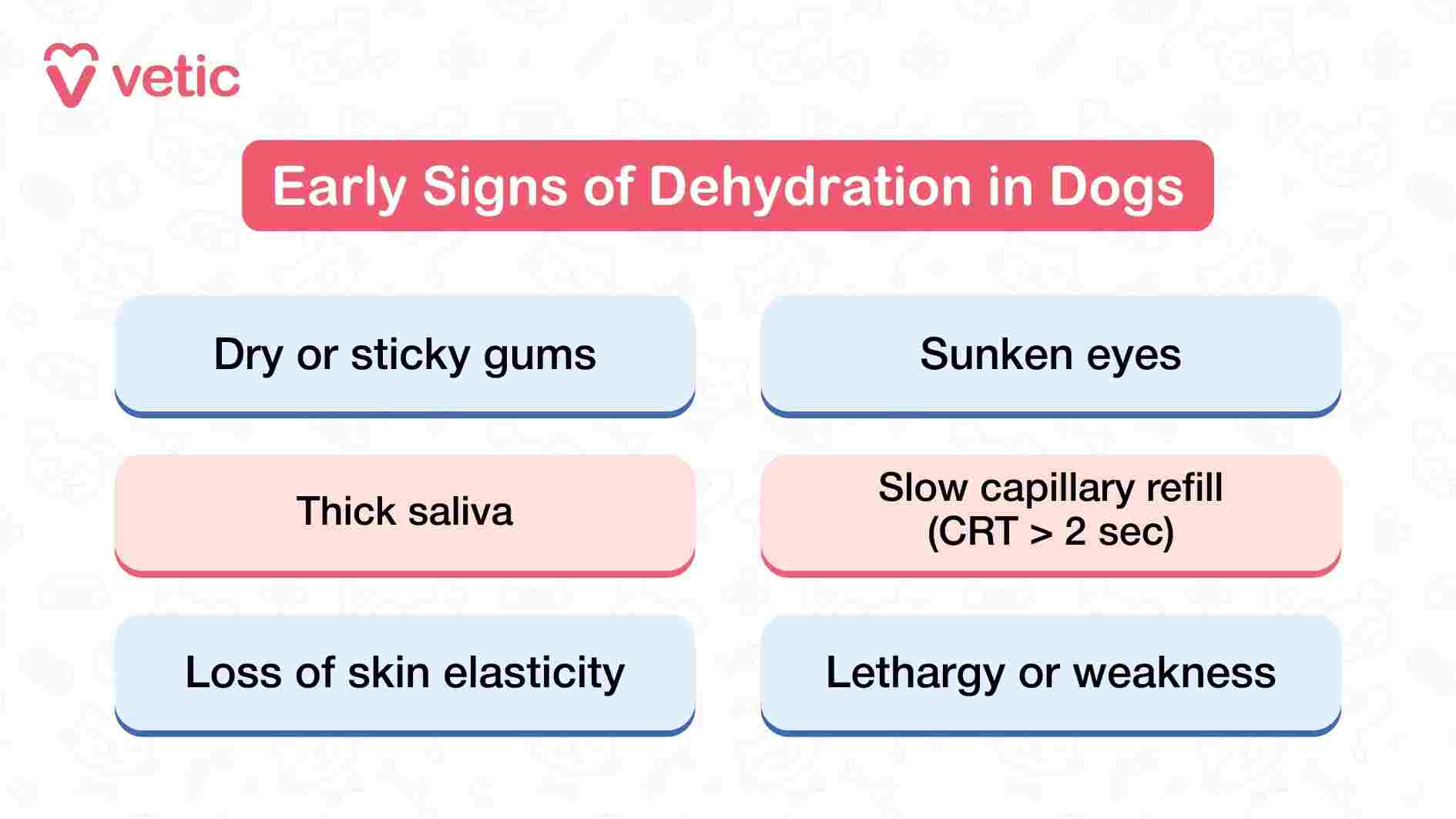
Dehydration in dogs often starts with subtle symptoms that can easily be missed. Watch out for:
- Dry or sticky gums
- Loss of skin elasticity
- Sunken eyes
- Thick saliva
- Lethargy or weakness
- Slow capillary refill time (CRT > 2 seconds)
These early signs mean your dog may already be losing vital fluids and electrolytes, a condition that can quickly worsen in high heat or during illness.
Causes of Dehydration in Dogs and Cats
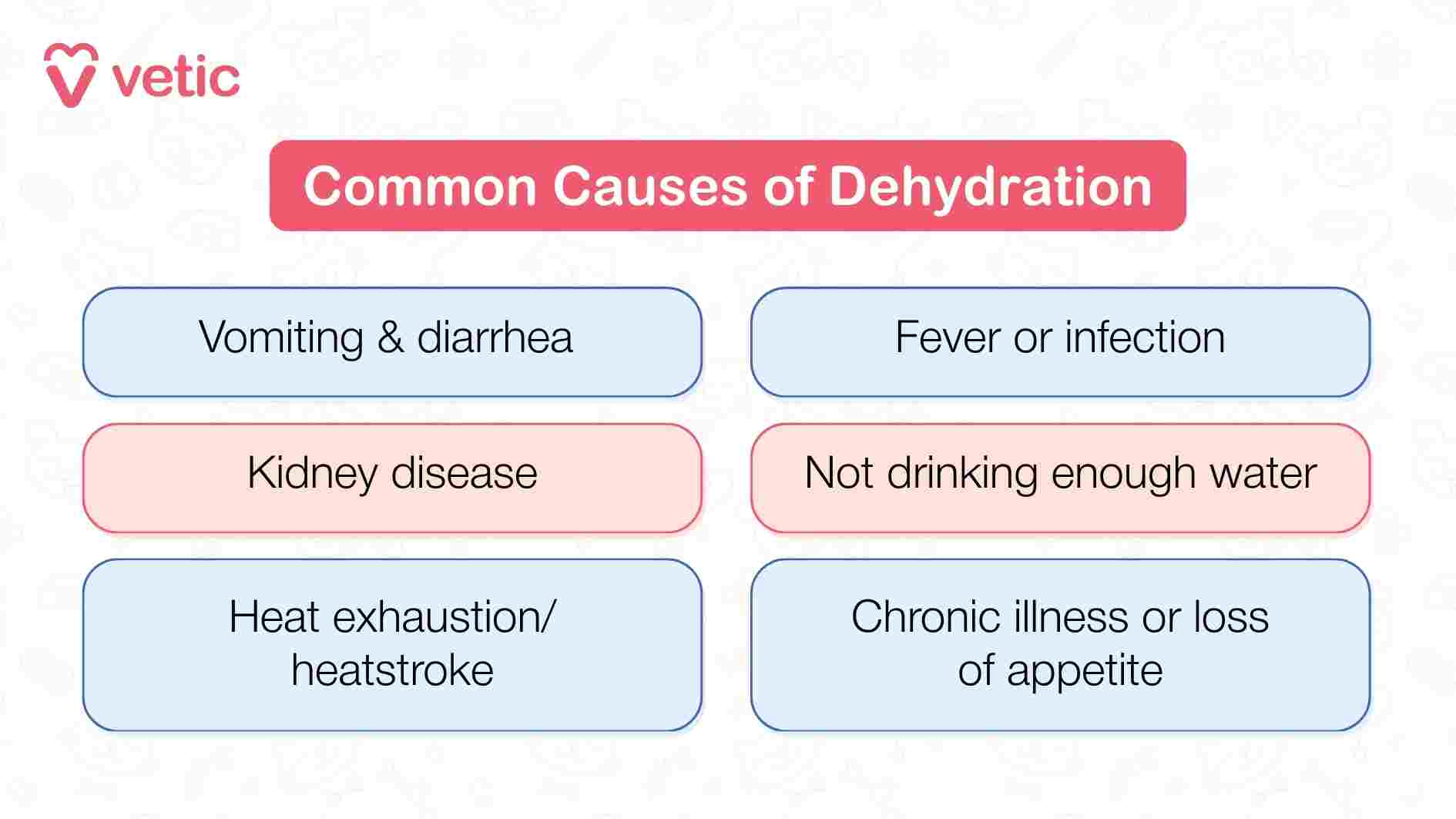
Dehydration is not a disease. It’s a symptom that results from fluid loss or insufficient water intake. The most common causes include:
- Vomiting and diarrhea – leading to rapid loss of fluids and salts.
- Fever or infection – increased body temperature causes excessive water loss.
- Kidney disease – reduces the body’s ability to retain fluids.
- Hot weather or overheating – heatstroke is a leading cause of dehydration in dogs and dehydration in cats.
- Not drinking enough water – common in picky pets or those fed dry kibble.
- Chronic illness or loss of appetite – leads to reduced water consumption.
Common Signs of Dehydration in Dogs and Cats
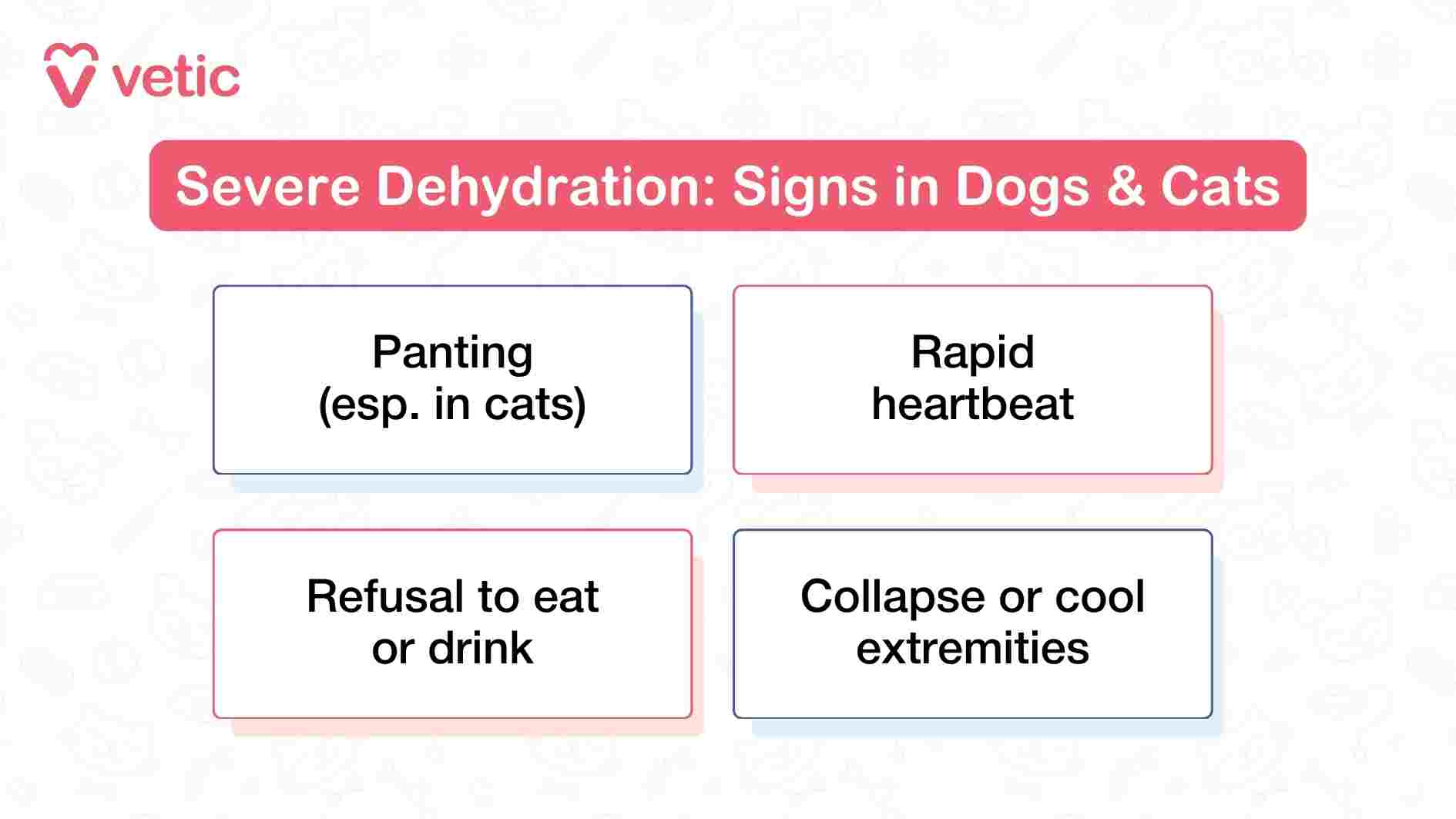
Early Signs of Dehydration in Dogs and Cats
- Dry nose and lips
- Sticky or pale gums
- Lethargy or reduced activity
- Sunken eyes
- Reduced skin elasticity
Severe Signs of Dehydration in Dogs and Cats
- Refusal to eat or drink
- Panting (especially in cats, which is abnormal)
- Rapid heart rate and collapse
- Cool extremities or signs of shock
Any of these symptoms requires immediate veterinary attention.
What Are The Signs of Dehydration in Cats?
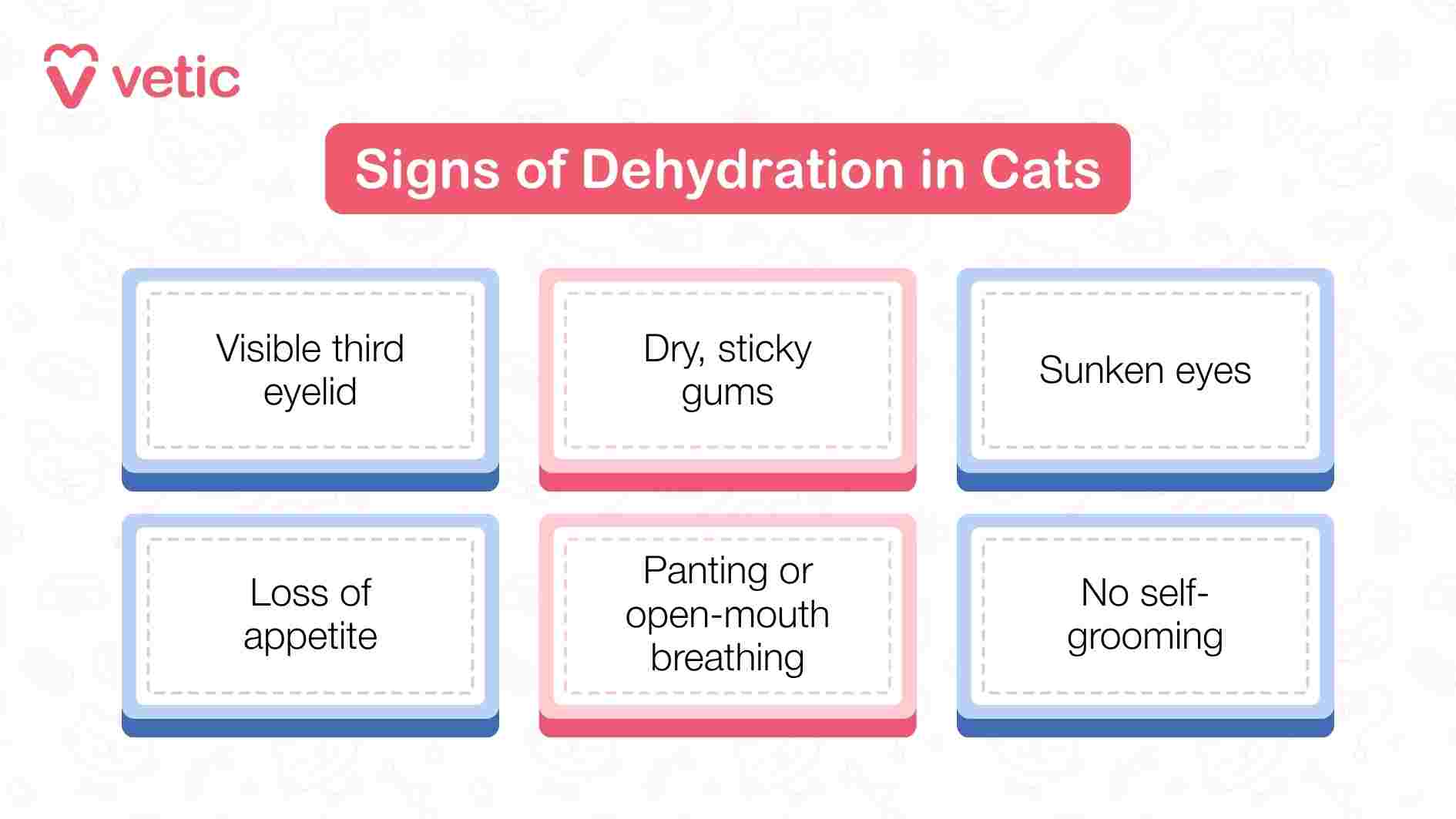
Cats are naturally secretive, and dehydration in cats can go unnoticed until it’s severe. Look for:
- Visible third eyelid or sunken eyes
- Dry, sticky gums
- Loss of appetite
- Panting or open-mouth breathing
- Lethargy and reduced grooming
If your cat refuses food or water for more than 8 hours, consult your veterinarian right away.
What Causes Dehydration in Cats and Dogs?
The underlying causes are similar for both species:
- Gastrointestinal upset (vomiting or diarrhea)
- Viral infections such as parvovirus
- Heatstroke or excessive exercise/play
- Inadequate water access
- Chronic illness or kidney disorders
Can I Protect My Cat or Dog from Dehydration During The Summers?
Yes! Prevention is always better than treatment.
Ensure Constant Access to Fresh Water
- Keep multiple water bowls in cool, shaded spots.
- Clean and refill bowls daily.
- Add chicken broth or low-sodium bone broth if your pet avoids plain water.
Avoid Heat Exposure
- Skip midday walks and playtime.
- Keep dogs indoors during peak heat hours.
- Provide cool mats or shaded resting spots for cats.
- Always carry a collapsible bowl and bottled water when travelling.
Switching to wet food or adding broth to meals can also prevent dehydration in summer.
How to Check if Dogs or Cats Are Dehydrated at Home
You can perform two quick, vet-approved checks at home:
- The Gum Test – Gently press your pet’s gum with your fingertip. In hydrated pets, the gum turns white briefly and returns to pink within a second. If it takes longer, dehydration is likely.
- The Skin Pinch Test – Gently lift the skin at the back of the neck or between the shoulders. In hydrated pets, it snaps back instantly. In dehydrated pets, it stays tented or returns slowly.
(Note: The test may not be accurate in very old or pets with excessive skin folds.)
How Dehydration in Dogs and Cats Is Treated
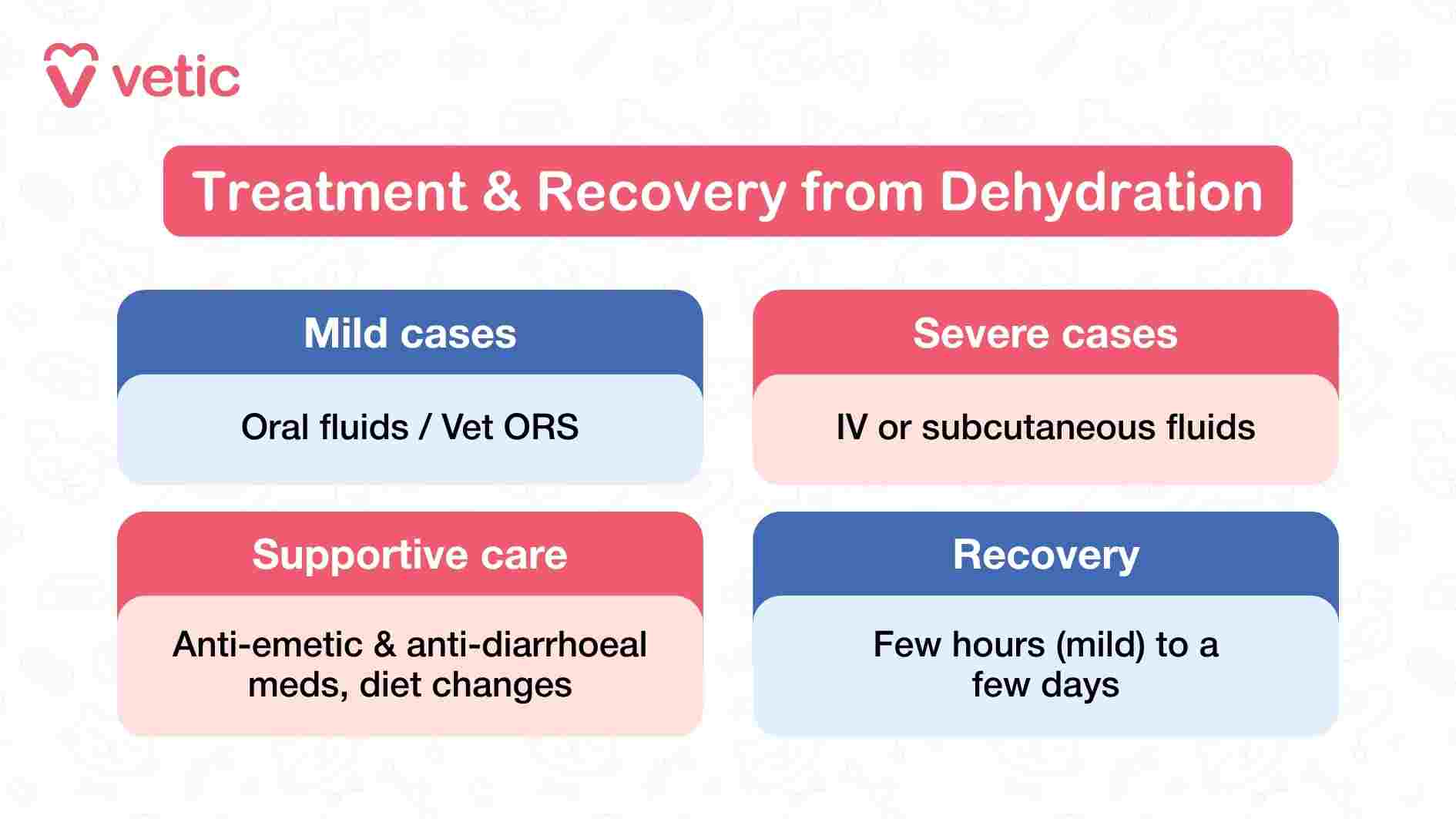
Treatment depends on the severity of dehydration and the underlying cause.
- Mild dehydration: Oral fluids or vet-approved ORS for dogs and ORS for cats to restore electrolyte balance.
- Moderate to severe dehydration: Subcutaneous or intravenous (IV) fluids administered by a vet.
- Supportive care: Antiemetics (for vomiting), antibiotics (for infections), and nutritional support to address the root cause.
Never attempt to rehydrate your pet using random home remedies or unapproved products — always consult your veterinarian first.
Recovery Time for Dehydration in Dogs and Cats
- Mild cases: Pets often recover within a few hours once they begin drinking water or receive oral fluids.
- Moderate to severe cases: May require 1 to 3 days of IV fluid therapy and hospitalization.
Continuous monitoring is essential to prevent relapse or kidney complications.
Can I Give Human ORS to My Dog or Cat?
Many pet parents wonder, “Can we give ORS to dogs?” or “Can we give ORS to cats?”
The answer: No, not without veterinary guidance.
Human ORS is formulated for human osmolarity and electrolyte balance — not for animals. It may contain inappropriate sugar or sodium levels that can upset your pet’s stomach or worsen vomiting.
Veterinary ORS for pets is specifically designed for canine and feline physiology, ensuring the right sodium-potassium balance and safe osmolality.
Choosing the Correct Oral Rehydration Salts (ORS) for Dehydration in Dogs and Cats
The best ORS for dogs or ORS for cats is one recommended by your veterinarian.
Veterinary-formulated ORS typically includes:
- Balanced electrolytes: Sodium, potassium, and chloride
- Glucose for energy absorption
- Amino acids and prebiotics (such as inulin)
- Optional micronutrients for senior or sick pets
Some advanced ORS products are designed for pets with chronic dehydration, kidney disorders, or nutrient deficiencies — they replenish both hydration and lost nutrition.
How to Give ORS to Dehydrated Dogs and Cats
- Mix the ORS sachet exactly as directed (usually with lukewarm boiled water).
- Use a syringe or dropper to give small amounts; about 0.5 ml per kg body weight every 2 hours.
- Offer small sips frequently rather than large gulps to prevent vomiting.
- For picky pets, try freezing dog ORS into ice cubes or popsicles.
- For cats, consult your vet for safe feeding techniques to avoid choking.
Time to See the Vet: Is Oral Rehydration Therapy (ORT) Always Enough?
Not always. ORS for pets is suitable only for mild dehydration.
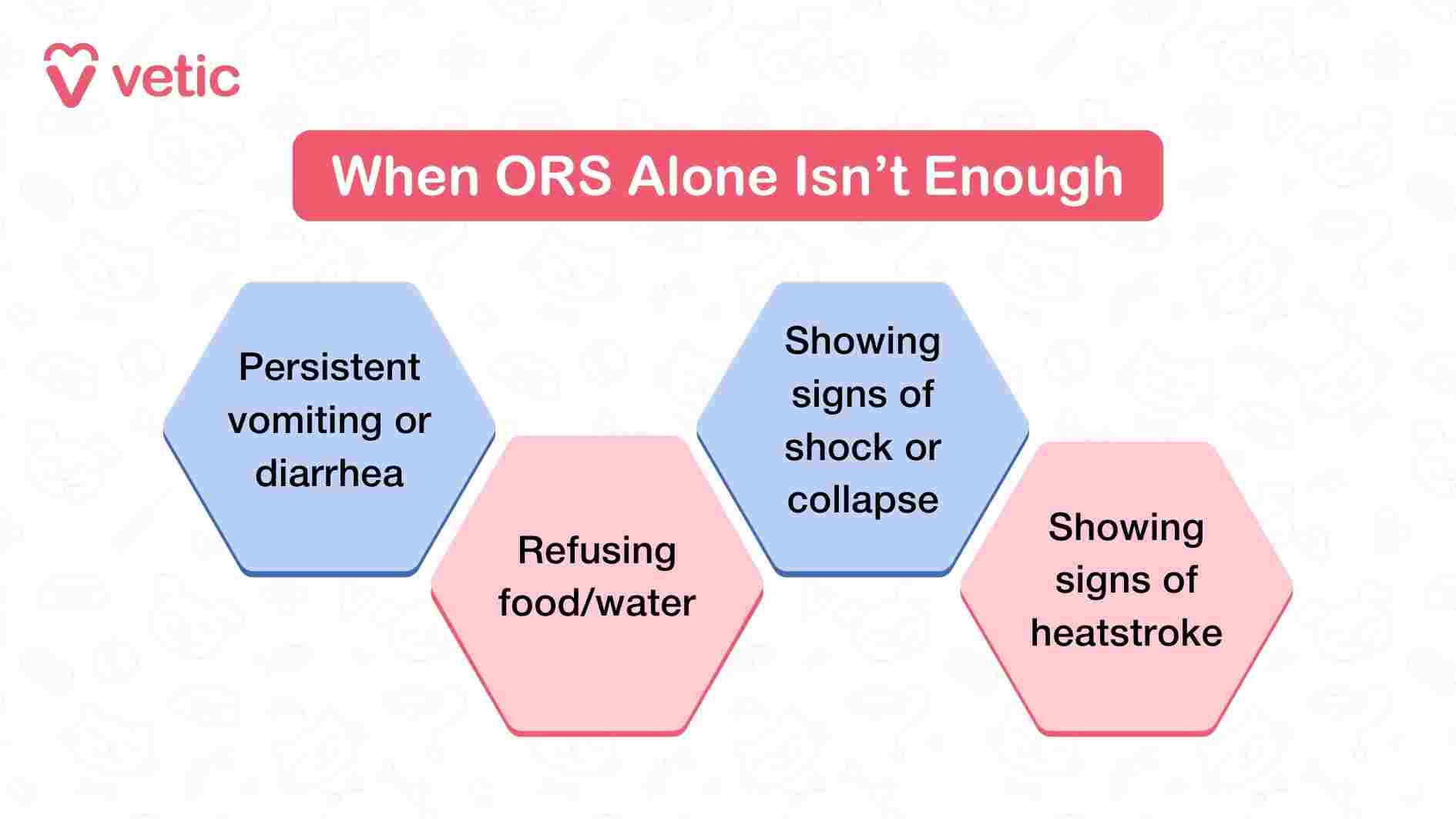 In moderate or severe cases, your vet may recommend:
In moderate or severe cases, your vet may recommend:
- Subcutaneous or IV fluid therapy
- Antibiotics or antiemetics if infection or vomiting is present
- Blood tests to assess organ function
Pets with persistent vomiting, diarrhea, or refusal to drink need urgent veterinary care. Delaying can lead to kidney failure or shock.
Dehydration can escalate rapidly but with quick action and the right care, your pet can recover fully.
Use vet-recommended ORS for dogs and cats, provide cool water, and prevent overheating during the summer.
Keep your pets safe. Book a health check with Vetic today to ensure your dog or cat stays healthy, hydrated, and happy.
FAQs on ORS for Dogs, Cats & Pet Dehydration
1. Can we give ORS to dogs at home?
Only under a vet’s advice. Use vet-formulated ORS for dogs; never human ORS, as the sodium levels differ.
2. Can we give human ORS to dogs?
No. Human ORS has unsuitable sugar and salt ratios for pets and may cause vomiting or worsen dehydration.
3. What’s the best ORS for dogs in India?
Use veterinary-approved ORS, as prescribed by your veterinarian for your dog’s hydration needs.
4. Can ORS be given to cats safely?
Yes, but only veterinary ORS designed for cats. Never give human formulations without consulting your veterinarian first.
5. How much ORS should I give my dog?
Generally, 0.5 ml per kg body weight every two hours but confirm dosage with your vet first. It might vary according to the level of dehydration, the age of your dog, and their kidney health.
6. Is ORS good for cats during summer?
Yes, vet-approved ORS can help restore lost fluids in summer, but keep your cat in a cool, ventilated room.
7. How long does it take for a dog to recover from dehydration?
Mild dehydration improves within hours with oral fluids; severe cases need 1–3 days of veterinary IV therapy.
8. What are the early signs of dehydration in pets?
Dry gums, sticky saliva, sunken eyes, lethargy, and loss of skin elasticity all need quick rehydration support.

